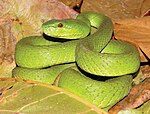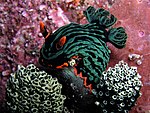Nino Konis Santana National Park
| Nino Konis Santana National Park Parque Nacional Nino Konis Santana | |
|---|---|
 Park logo | |
 | |
| Location | East Timor |
| Nearest city | Tutuala |
| Coordinates | 8°27′00″S 127°20′00″E / 8.45000°S 127.33333°E |
| Area | 1,236 km2 |
| Established | 2007 |
| Governing body | Department of Protected Areas and National Parks, East Timor |
The Nino Konis Santana National Park is
The park is named in honor of the independence movement national hero Nino Konis Santana, a former commander of Falintil, who was born in Tutuala, a village within the borders of the national park.[1][2]
History
Part of the park first became a natural conservation reserve during the occupation of the country by
Following the independence of the country in 2002, along with the scientific assessment of Important Bird Areas in the country, action to identify and declare the first National Park was also undertaken by
Geography
Located at the eastern tip of the island, the park covers 125,600 hectares (310,000 acres), It is constituted by a terrestrial area of 68,000 hectares (170,000 acres) constituting lowland, tropical and monsoon forest; and a marine area of 55,600 hectares (137,000 acres), part of the Coral Triangle.[5][6] The national park also links the Important Bird Areas of Loré, Monte Paitchau, Lake Ira Lalaro and Jaco Island, identified through biological surveys undertaken by BirdLife International after the country attained independence in 2002, which cover 25,000 hectares (62,000 acres) of the park.[1][7]
There are six villages within the national park, including Bauro, Com, Tutuala, Méhara and Maupitine, while Malahara is a hamlet. Former settlements include Mua Mimiraka, Lo Chami, and Lori Lata. Walled settlements are found at Tutuala, Lori Lata, Lopomalai, Ili Mimiraka, Mua Mimiraka, and Tutun (Tutunca'u). Lautem District features Lake Iralaloro. Shell midden sites are situated at Kusu Midden and
Moist deciduous lowland forest and
Wildlife
Flora
Vegetation types which are part of the common usage of the people are medicinal plants, bamboo, and canoe trees.[10] The lake's flood plains have grass vegetation which are used by the villagers of Mehara and Maupitine for grazing their livestock. Wetlands of the flood plains are also used for growing rice and tobacco, and also distilling palm liquor as part of their living needs.[11]
Fauna
There are Timor endemic and scientifically undescribed shrews and bat species in the park. More than 20 native bat species have been recorded in the park. There are also a series of described and undescribed giant rats known from sub-fossil deposits, which may now be extinct. Several mammals were introduced from outside the island during late prehistoric and historic times when people had started inhabiting the area. Some of the common species seen in the wild are birds, bats, murids and most commonly exploited northern common cuscus (Phalanger orientalis) which is reported to have been introduced from Papua New Guinea about 9,000 years ago.[12]
The Coral Triangle part of the park is one of the greatest diversity areas for coral and coral reef fish in the world.
Avifauna
The terrestrial area of the park has 200 bird species, of which the endangered species are
- Dusky cuckoo-doveMacropygia magna
- Slaty cuckoo-doveTuracoena modesta (NT, RR)
- Timor green-pigeonTreron psittaceus (EN, RR)
- Pink-headed imperial-pigeonDucula rosacea (NT, RR)
- Yellow-crested cockatoo Cacatua sulphurea (CR)
- Olive-shouldered parrotAprosmictus jonquillaceus (RR)
- Cinnamon-banded kingfisher Todiramphus australasia (RR)
- Streaky-breasted honeyeaterMeliphaga reticulata (RR)
- Plain friarbirdPhilemon inornatus (RR)
- Yellow-eared honeyeaterLichmera flavicans (RR)
- Red-rumped myzomelaMyzomela vulnerata (RR)
- Plain gerygone Gerygone inornata (RR)
- Fawn-breasted whistler Pachycephala orpheus (RR)
- Timor figbirdSphecotheres viridis (RR)
- Olive-brown oriole Oriolus melanotis (RR)
- Timor stubtail Urosphena subulata (RR)
- Spot-breasted white-eyeHeleia muelleri (NT, RR)
- Orange-banded thrushZoothera peronii (NT, RR)
- White-bellied bushchatSaxicola gutturalis (NT)
- Black-banded flycatcher Ficedula timorensis (NT)
- Timor blue-flycatcherCyornis hyacinthinus (RR)
- Red-chested flowerpecker Dicaeum maugei (RR)
- Flame-breasted sunbird Nectarinia solaris (RR)
- Tricoloured parrotfinchErythrura tricolor (RR)
Legend: CR - critically endangered; EN - endangered; NT - near threatened; RR - restricted-range (global range less than 50,000 km2)
Cultural value

Over 200 cultural sites have been identified within the national park. The settlements in the park are inhabited by
See also
References
- ^ a b c d e f "East Timor declares first national park". BirdLife News. 3 August 2007. Retrieved 22 July 2013.
- ^ a b c Miksic, Goh & O'Connor 2011, pp. 40–41.
- ^ The Emu: Official Organ of the Australasian Ornithologists' Union. Royal Australasian Ornithologists Union. 2008. Retrieved 23 July 2013.
- ^ a b Miksic, Goh & O'Connor 2011, p. 41.
- ^ a b Sparks 2008, p. 239.
- ^ Miksic, Goh & O'Connor 2011, pp. 40, 43.
- ISBN 978-1-74220-377-5.
- ^ Miksic, Goh & O'Connor 2011, pp. 39–64.
- ^ a b "BirdLife IBA Factsheet". BirdLife International. Retrieved 22 July 2013.
- ^ a b Miksic, Goh & O'Connor 2011, p. 43.
- ^ a b Miksic, Goh & O'Connor 2011, p. 45.
- ^ Miksic, Goh & O'Connor 2011, pp. 43–45.
- ^ Miksic, Goh & O'Connor 2011, p. 49.
- ^ a b Miksic, Goh & O'Connor 2011, pp. 53–61.
Bibliography
- ISBN 978-0-85728-389-4.
- Sparks, Karen Jacobs (2008). Encyclopædia Britannica 2008. Encyclopædia Britannica (India) Pvt. Limited. ISBN 978-1-59339-425-7.
Further reading
- Cowie, Ian (May 2006). "A Survey of Flora and Vegetation of the Proposed Jaco– Tutuala–Lore National Park, Timor-Leste (East Timor)" (PDF). Department of Environment, Parks and Water Security.







